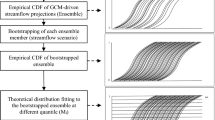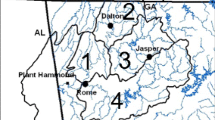Abstract
Interest in the impacts of climate change is ever increasing. This is particularly true of the water sector where understanding potential changes in the occurrence of both floods and droughts is important for strategic planning. Climate variability has been shown to have a significant impact on UK climate and accounting for this in future climate change projections is essential to fully anticipate potential future impacts. In this paper a new resampling methodology is developed which includes the variability of both baseline and future precipitation. The resampling methodology is applied to 13 CMIP3 climate models for the 2080s, resulting in an ensemble of monthly precipitation change factors. The change factors are applied to the Eden catchment in eastern Scotland with analysis undertaken for the sensitivity of future river flows to the changes in precipitation. Climate variability is shown to influence the magnitude and direction of change of both precipitation and in turn river flow, which are not apparent without the use of the resampling methodology. The transformation of precipitation changes to river flow changes display a degree of non-linearity due to the catchment’s role in buffering the response. The resampling methodology developed in this paper provides a new technique for creating climate change scenarios which incorporate the important issue of climate variability.












Similar content being viewed by others
References
Arnell NW (2003) Relative effects of multi-decadal climatic variability and changes in the mean and variability of climate due to global warming: future streamflows in Britain. J Hydrol 270:195–213
Arnell NW (2010) The relationship between climate forcing and hydrological response in UK catchments. Hydrol Earth Syst Sci Discuss 7:7633–7667
Bell VA, Moore RJ (1999) An elevation-dependent snowmelt model for upland Britain. Hydrol Process 13:1887–1903
Bell VA, Kay AL, Jones RG, Moore RJ (2007) Use of a grid-based hydrological model and regional climate model outputs to assess changing flood risk. Int J Climatol 27:1657–1671
Beven K (2006) A manifesto for the equifinality thesis. J Hydrol 320:18–36
Beven K (2011) I believe in climate change but how precautionary do we need to be in planning for the future? Hydrol Process 25:1517–1520
Cameron D, Beven K, Naden P (2000) Flood frequency estimation by continuous simulation under climate change (with uncertainty). Hydrol Earth Syst Sci 4:393–405
Chiew FHS, Teng J, Vaze J, Kirono DGC (2009) Influence of global climate model selection on runoff impact assessment. J Hydrol 379:172–180
Christensen JH, Kjellstrom E, Giorgi F, Lenderink G, Rummukainen M (2010) Weight assignment in regional climate models. Clim Res 44:179–194
Crooks SM, Kay AL, Reynard N (2010) Regionalised impacts of climate change on flood flows: hydrological models, catchments and calibration. Milestone report 1, Defra
Diaz-Nieto J, Wilby RL (2005) A comparison of statistical downscaling and climate change factor methods: impacts on low flows in the River Thames, United Kingdom. Clim Chang 69:245–268
Fowler HJ, Kilsby CG, O’connell PE, Burton A (2005) A weather-type conditioned multi-site stochastic rainfall model for the generation of scenarios of climatic variability and change. J Hydrol 308:50–66
Fowler HJ, Blenkinsop S, Tebaldi C (2007) Linking climate change modelling to impacts studies: recent advances in downscaling techniques for hydrological modelling. Int J Climatol 27:1547–1578
Frei C, Scholl R, Fukutome S, Schmidli J, Vidale PL (2006) Future change of precipitation extremes in Europe: intercomparison of scenarios from regional climate models. J Geophys Res-Atmos 111
Hawkins E, Sutton R (2009) The potential to narrow uncertainty in regional climate predictions. Bull Am Meteorol Soc 90:1095–1107
Hawkins E, Sutton R (2010) The potential to narrow uncertainty in projections of regional precipitation change. Clim Dynam
Hay LE, Wilby RJL, Leavesley GH (2000) A comparison of delta change and downscaled GCM scenarios for three mountainous basins in the United States. J Am Water Resour Assoc 36:387–397
Haylock MR, Cawley GC, Harpham C, Wilby RL, Goodess CM (2006) Downscaling heavy precipitation over the United Kingdom: a comparison of dynamical and statistical methods and their future scenarios. Int J Climatol 26:1397–1415
Hurrell JW, Visbeck MH, Polvani L, Cullen HM (2001) The North Atlantic oscillation: past, present, and future. Proc Natl Acad Sci U S A 98:12876–12877
Jones RN, Chiew FHS, Boughton WC, Zhang L (2006) Estimating the sensitivity of mean annual runoff to climate change using selected hydrological models. Adv Water Resour 29:1419–1429
Jones PD, Kilsby CG, Hapham C, Glenis V, Burton A (2009) UK climate projections science report: projections of future daily climate for the UK from the Weather Generator, University of Newcastle, UK
Kay AL, Davies HN, Bell VA, Jones RG (2009) Comparison of uncertainty sources for climate change impacts: flood frequency in England. Clim Chang 92:41–63
Kendon EJ, Rowell DP, Jones RG, Buonomo E (2008) Robustness of future changes in local precipitation extremes. J Clim 21:4280–4297
Knutti R, Abramwitz G, Collins M, Eyring V, Gleckler PJ, Hewitson B, Mearns L (2010a) Good practice guidance paper on assessing and combining multi model climate projections. Meeting report of the intergovernmental panel on climate change expert meeting on assessing and combining multi model climate projections. In: Stocker TF, Qin D, Plattner GK, Tignor M, Midgley PM (eds) IPCC Working Group l Technical Support Unit. University of Bern, Bern
Knutti R, Furrer R, Tebaldi C, Cermak J, Meehl GA (2010b) Challenges in combining projections from multiple climate models. J Clim 23:2739–2758
Marshall J, Kushner Y, Battisti D, Chang P, Czaja A, Dickson R, Hurrell J, Mccartney M, Saravanan R, Visbeck M (2001) North Atlantic climate variability: phenomena, impacts and mechanisms. Int J Climatol 21:1863–1898
Meehl GA, Covey C, Taylor KE, Delworth T, Stouffer RJ, Latif M, Mcavaney B, Mitchell JFB (2007) THE WCRP CMIP3 multimodel dataset: a new era in climate change research. Bull Am Meteorol Soc 88:1383–1394
Moore RJ (2007) The PDM rainfall-runoff model. Hydrol Earth Syst Sci 11:483–499
Moore RV, Morris DG, Flavin RW (1994) Sub-set of UK digital 1:50,000 scale river centre-line network. NERC, Institute of Hydrology, Wallingford
Morris DG, Flavin RW (1990) A digital terrain model for hydrology. Proc 4th International Symposium on Spatial Data Handling. Vol 1 Jul 23–27 Zurich, pp 250–262. Morris DG and Flavin RW, 1994. Sub-set of UK 50 m by 50 m hydrological digital terrain model grids. Wallingford, Nerc, Institute of Hydrology
Murphy JM, Sexton DMH, Barnett DN, Jones GS, Webb MJ, Collins M (2004) Quantification of modelling uncertainties in a large ensemble of climate change simulations. Nature 430:768–772
Murphy JM, Sexton DMH, Jenkins GJ, Boorman PM, Booth BBB, Brown CC, Clark RT, Collins M, Harris GR, Kendon EJ, Betts RA, Brown SJ, Howard TP, Humphreys KA, Mccarthy MP, Mcdonald RE, Stephens A, Wallace C, Warren R, Wilby R, Wood RA (2009) UK climate projections science report: climate change projections. Met Office Hadley Centre, Exeter
Nash JE, Sutcliffe JV (1970) River flow forecasting through conceptual models. 1. A discussion of principles. J Hydrol 10:282–290
New M, Lopez A, Dessai S, Wilby R (2007) Challenges in using probabilistic climate change information for impact assessments: an example from the water sector. Phil Trans Roy Soc A-Math Phys Eng Sci 365:2117–2131
Parker D, Folland C, Scaife A, Knight J, Colman A, Baines P, Dong BW (2007) Decadal to multidecadal variability and the climate change background. J Geophys Res-Atmos 112
Prudhomme C, Jakob D, Svensson C (2003) Uncertainty and climate change impact on the flood regime of small UK catchments. J Hydrol 277:1–23
Prudhomme C, Wilby RL, Crooks S, Kay AL, Reynard NS (2010) Scenario-neutral approach to climate change impact studies: application to flood risk. J Hydrol 390:198–209
Raisanen J, Ruokolainen L (2006) Probabilistic forecasts of near-term climate change based on a resampling ensemble technique. Tellus A 58:461–472
Ruokolainen L, Raisanen J (2007) Probabilistic forecasts of near-term climate change: sensitivity to adjustment of simulated variability and choice of baseline period. Tellus A 59:309–320
Schneider SH (1983) CO2, climate and society: a brief overview. In: Chen RS, Boulding E, Schneider SH (eds) Social science research and climate change: an interdisciplinary appraisal. MA, USA
Stainforth DA, Aina T, Christensen C, Collins M, Faull N, Frame DJ, Kettleborough JA, Knight S, Martin A, Murphy JM, Piani C, Sexton D, Smith LA, Spicer RA, Thorpe AJ, Allen MR (2005) Uncertainty in predictions of the climate response to rising levels of greenhouse gases. Nature 433:403–406
Tebaldi C, Knutti R (2007) The use of the multi-model ensemble in probabilistic climate projections. Phil Trans Roy Soc A-Math Phys Eng Sci 365:2053–2075
Tebaldi C, Lobell DB (2008) Towards probabilistic projections of climate change impacts on global crop yields. Geophys Res Lett 35
Vidal JP, Wade S (2008) A framework for developing high-resolution multi-model climate projections: 21st century scenarios for the UK. Int J Climatol 28:843–858
Weigel AP, Knutti R, Liniger MA, Appenzeller C (2010) Risks of model weighting in multimodel climate projections. J Clim 23:4175–4191
Wilby RL (2005) Uncertainty in water resource model parameters used for climate change impact assessment. Hydrol Process 19:3201–3219
Wilby RL, Harris I (2006) A framework for assessing uncertainties in climate change impacts: low-flow scenarios for the River Thames, UK. Water Resour Res 42:10
Wilby RL, Beven KJ, Reynard NS (2008) Climate change and fluvial flood risk in the UK: more of the same? Hydrol Process 22:2511–2523
Wood AW, Leung LR, Sridhar V, Lettenmaier DP (2004) Hydrologic implications of dynamical and statistical approaches to downscaling climate model outputs. Clim Chang 62:189–216
Woollings T (2010) Dynamical influences on European climate: an uncertain future. Phil Trans Roy Soc A-Math Phys Eng Sci 368:3733–3756
Xu CY (1999) From GCMs to river flow: a review of downscaling methods and hydrologic modelling approaches. Prog Phys Geogr 23:229–249
Acknowledgements
This research was funded by the Water Science programme of the NERC Centre for Ecology and Hydrology, who also fund the PhD project that this work is part of. Thanks to Alison Kay for providing calibrated PDM parameters. The authors would also like to thank the three anonymous reviewers for their constructive comments; in particular for suggestions regarding the analysis of precipitation sequencing.
Author information
Authors and Affiliations
Corresponding author
Rights and permissions
About this article
Cite this article
Ledbetter, R., Prudhomme, C. & Arnell, N. A method for incorporating climate variability in climate change impact assessments: Sensitivity of river flows in the Eden catchment to precipitation scenarios. Climatic Change 113, 803–823 (2012). https://doi.org/10.1007/s10584-011-0386-0
Received:
Accepted:
Published:
Issue Date:
DOI: https://doi.org/10.1007/s10584-011-0386-0




